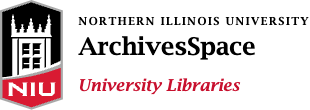World's Columbian Exposition ephemera collection
Content Description
Within this collection is an assortment of artifacts pertaining to the World’s Columbian Exposition. Series I, Stereographs, contains black and white stereocard views of buildings of the fair; all views were taken circa 1892 to 1893.
Series II, Printed Ephemera, is comprised of published material, tickets, passes and advertisement cards. Various businesses used the platform of the world’s fair to advertise their wares. This material was produced with the intention of either being given away or purchased by visitors as souvenirs. The Singer Manufacturing Co. 1893 souvenir cards— Costumes of All Nations—claim to be “lithographed reproductions of photographs taken on the spot in various countries and provinces, and later colored.” They were described as native costume studies, “reliable and perfect in every detail.” Notably, on each card, the individuals are photographed with a Singer sewing machine.
Series III, Memorabilia, consists of a sampling of the souvenirs available to the public such as commemorative coins, silver spoons, jewelry and other artifacts. These souvenirs are decorated with images of the fair, particularly an image of the Fair’s most remembered feature, the Ferris Wheel. Designed by George Washington Gage Ferris Jr., the “Chicago Wheel” was a response to the success of the Eiffel Tower, unveiled at the 1889 Exposition Universelle in Paris. The wheel stood 264 feet high and featured 36 gondolas, each capable of holding up to 60 riders. An engineering marvel, it became the Fair’s most prominent attraction, and like the Exposition itself, was used to promote civic pride and display American ingenuity. The final series, Scrapbook, is composed of a single volume scrapbook compiled by an unknown creator, that contains newspaper articles and images, along with other clippings and textile sample commemorating the exposition of 1893.
Dates
- Creation: circa 1886-1977
- Creation: Majority of material found in 1893
Language of Materials
Bulk of materials in English; some printed material in German.
Conditions Governing Access
Collection is open for research under the terms of the NIU Rare Books and Special Collections archivist. Artifacts in Series II & IV contain fragile material that requires supervised use; consult the repository for details.
Restrictions, where applicable, are noted at the item level.
Conditions Governing Use
Property Rights are transferred to the University Libraries per the signed Deed of Gift Document. Literary Rights are retained by the content creator. Any copyrights so stated in the materials remain in force.
Historical Note
The World's Columbian Exposition, best known as the Chicago World's Fair, was organized in celebration of the Columbian quadricentennial. The expansive fairgrounds were opened to the public on May 1, 1893 until October 30, 1893. These grounds were designed by Frederick Law Olmstead and covered more than 630 acres across Jackson Park and the Midway Plaisance. Daniel Burnham oversaw the construction of nearly 200 new buildings for the fair.
The fair is recognized today as one of the defining moments of American cultural history and was especially influential in the fields of architecture and urban planning across the nation. The fair was also colloquially known as the White City for its uniformly white buildings built in the Beaux Arts and classical architecture styles and illuminated by innovative electric lights. Over 27 million people visited the exhibition halls which featured a great number of exhibitions on science, technology, art and the humanities alongside popular attractions such as sideshows, ethnic villages and displays of traditional ethnic dances, daily concerts by John Philip Sousa’s concert band, and the world’s first Ferris Wheel. The duality of modes of attractions found within the World’s Columbian Exposition fairgrounds exemplified Gilded Age class disparities. While the design and arrangement of its structures within the ‘White City’ represent the pinnacle of upper-class culture and arts, the adjacent Midway Plaisance with its ‘exotic’ displays and ‘lowbrow’ attractions became the amusement locale of choice for the working-class visitors.
Visitors were eager to take a piece of the fair home with them. There were countless souvenir stands throughout the fair that sold everything from books and maps to cups and saltshakers. Commemorative plates, cups, and spoons were very popular souvenirs at the fair. In 1894, shortly after the fair’s close, a fire swept through the fairgrounds resulting in the destruction of many structures. Despite this, the triumph of the World's Columbian Exposition revivified the American world's fair movement and set a standard against which every subsequent exposition would be measured.
Full Extent
5.15 Linear Feet : (Includes printed materials, stereographs, scrapbook and other memorabilia).
Abstract
Collection of stereographs of exposition grounds, memorabilia, and other ephemera from the World’s Columbian Exposition of 1893. It includes artifacts representative of the popular attractions at the fair and the souvenirs made available for the public. Also included is a scrapbook containing newspaper clippings and other printed ephemera in both English and German pertaining to the exposition. The original provenance of artifacts is unknown.
Arrangement
The collection is arranged in 4 series:
Immediate Source of Acquisition
Materials donated by Susan Chemler July 2018.
Separated Materials
Other material from the same donation was separated from archival collection and cataloged in the Rare Books Collection. Consult the repository for access details. See below for list of titles.
Processing Information
This finding aid was created by graduate assistants April Sanchez and Sean Carter under the supervision of Nora Jiménez, NIU Academic Archivist in March 2023.
- Title
- World's Columbian Exposition ephemera collection
- Status
- Completed
- Author
- Nora Jiménez, Archivist, NIU Special Collections and Archives
- Date
- May 2024
- Description rules
- Describing Archives: A Content Standard
- Language of description
- English
- Script of description
- Latin
Repository Details
Part of the Northern Illinois University Repository
Founders Memorial Library
Northern Illinois University
DeKalb IL 60115 US
815-753-9392
rhcua@niu.edu

